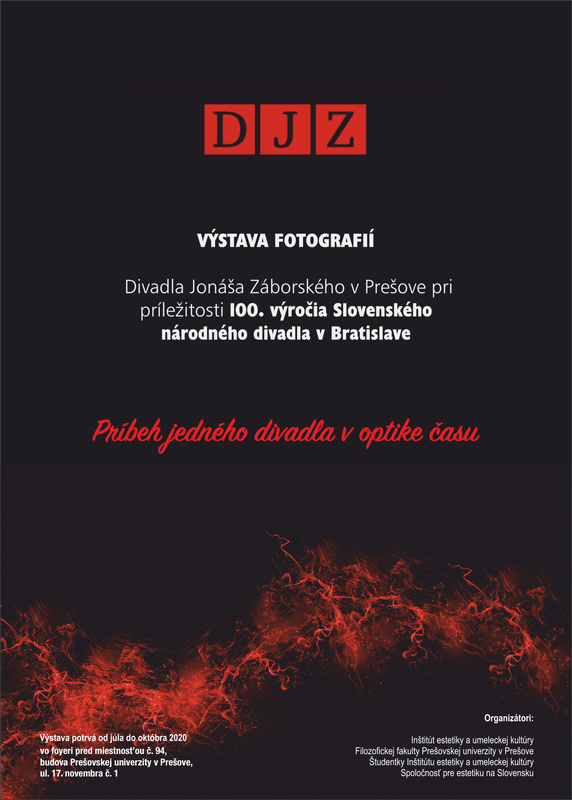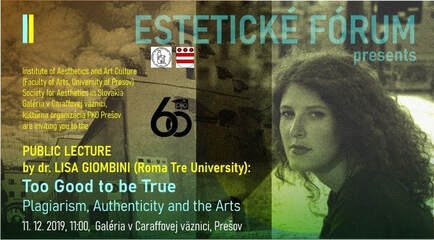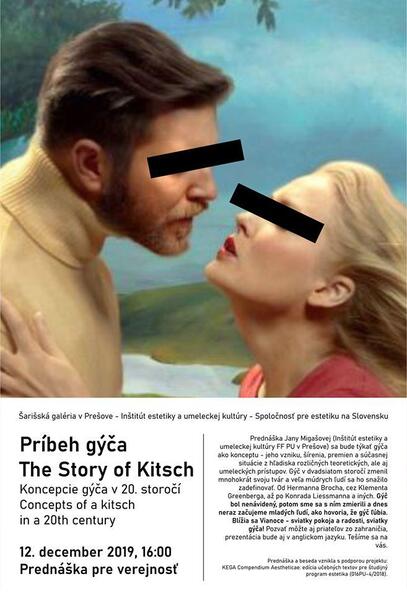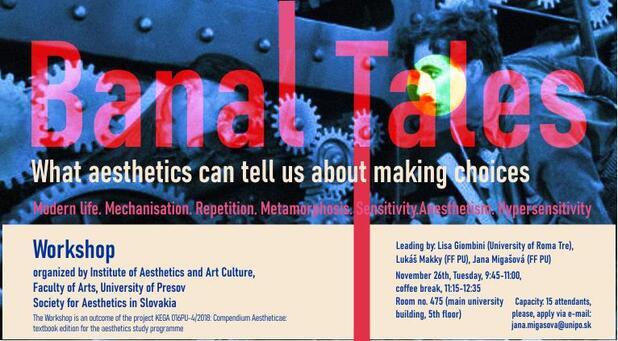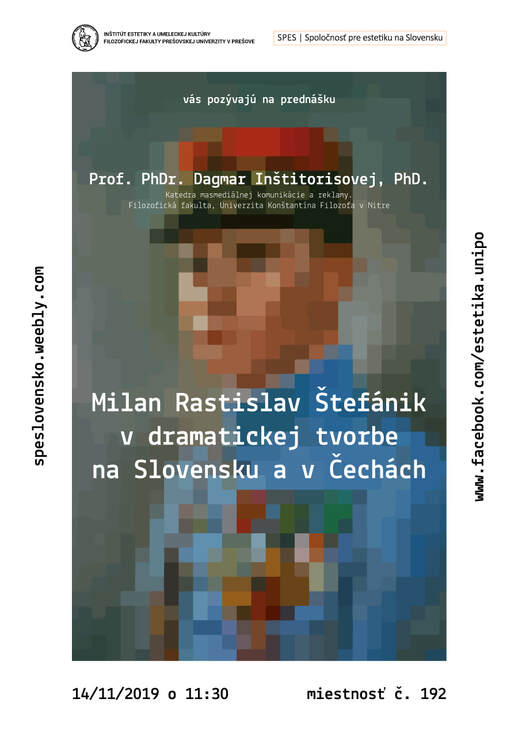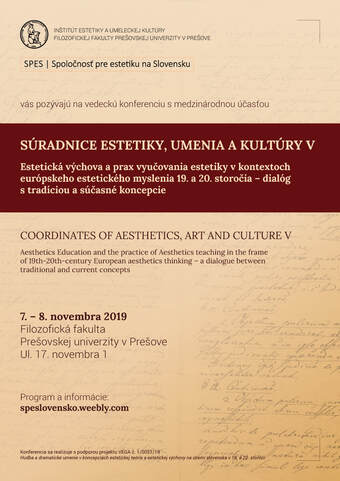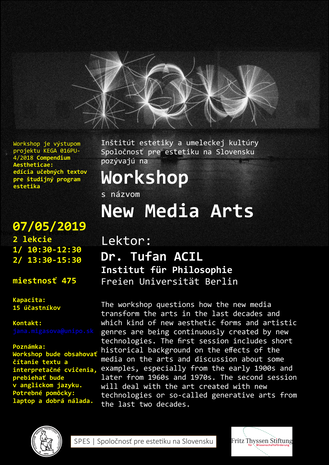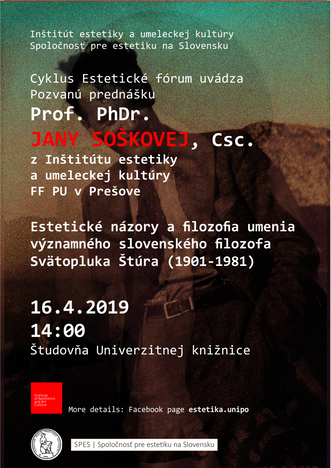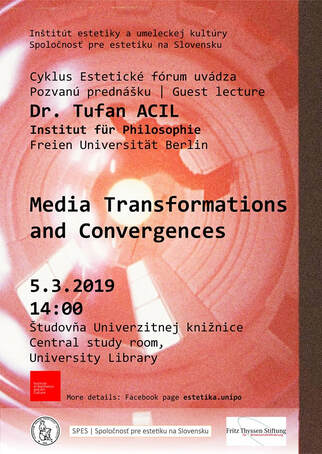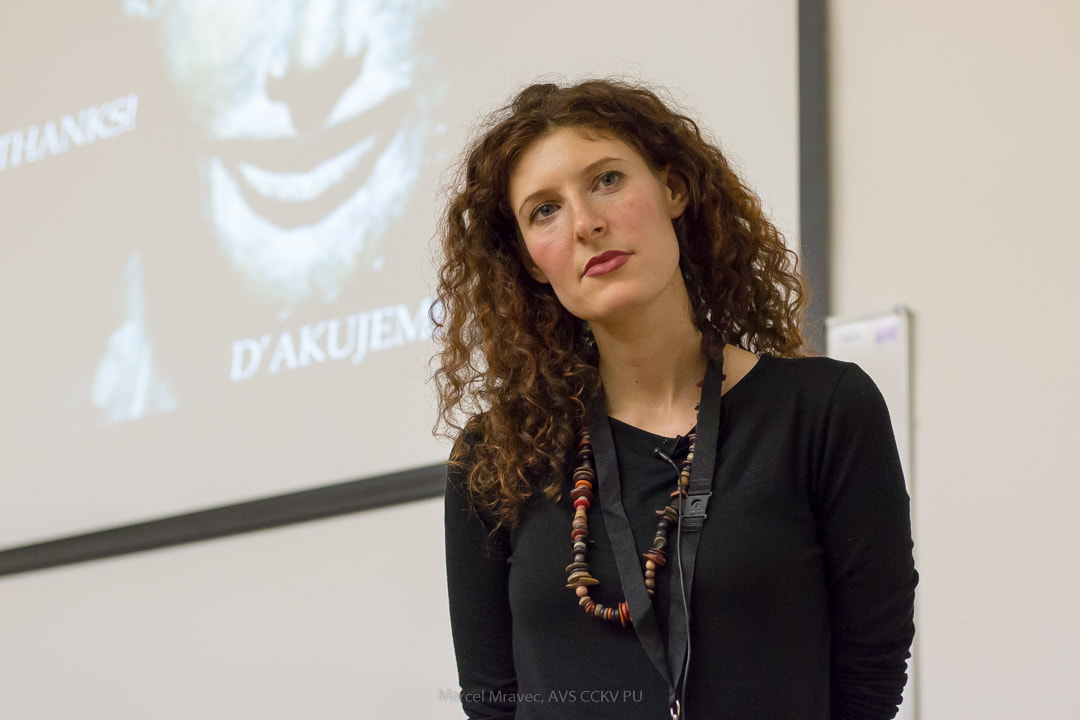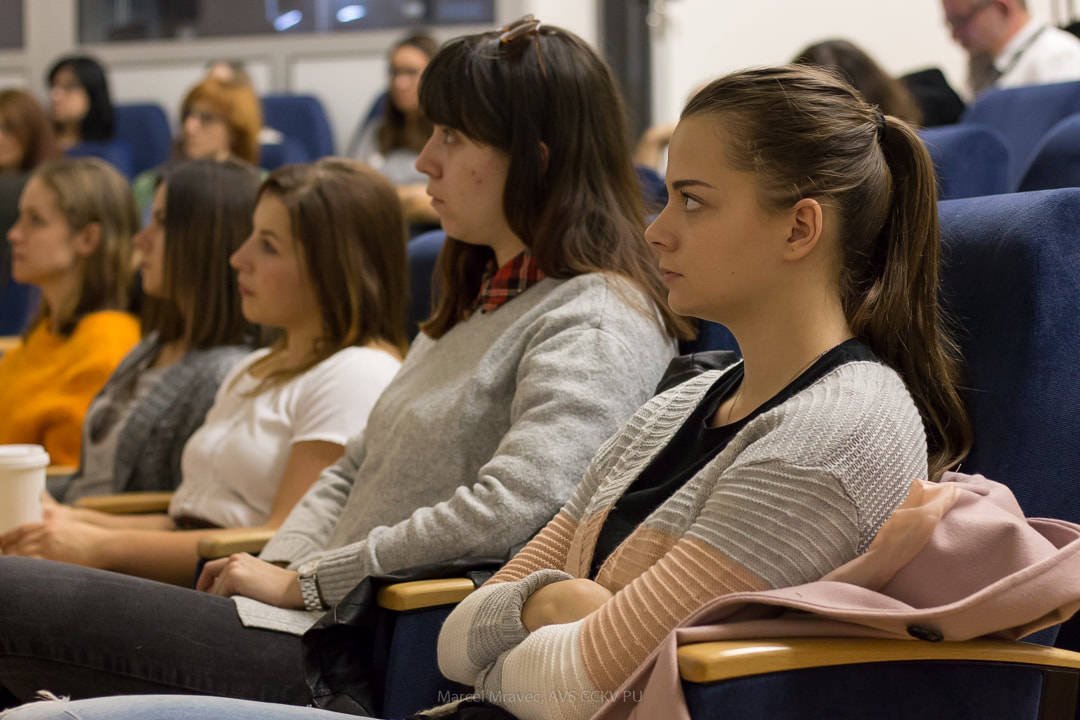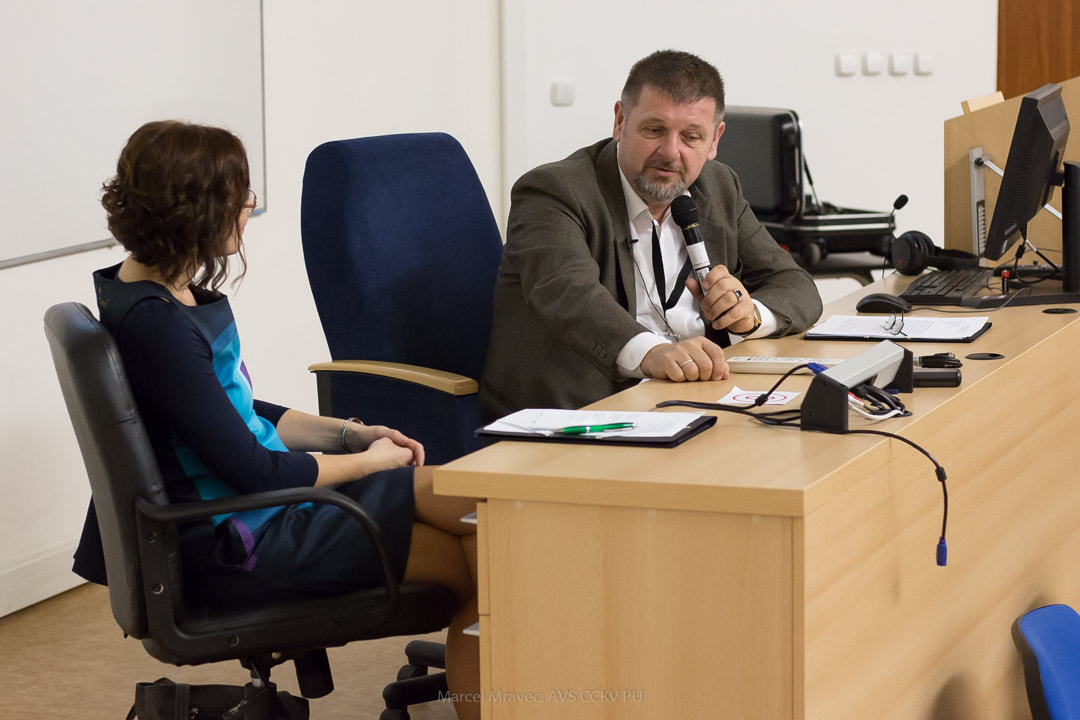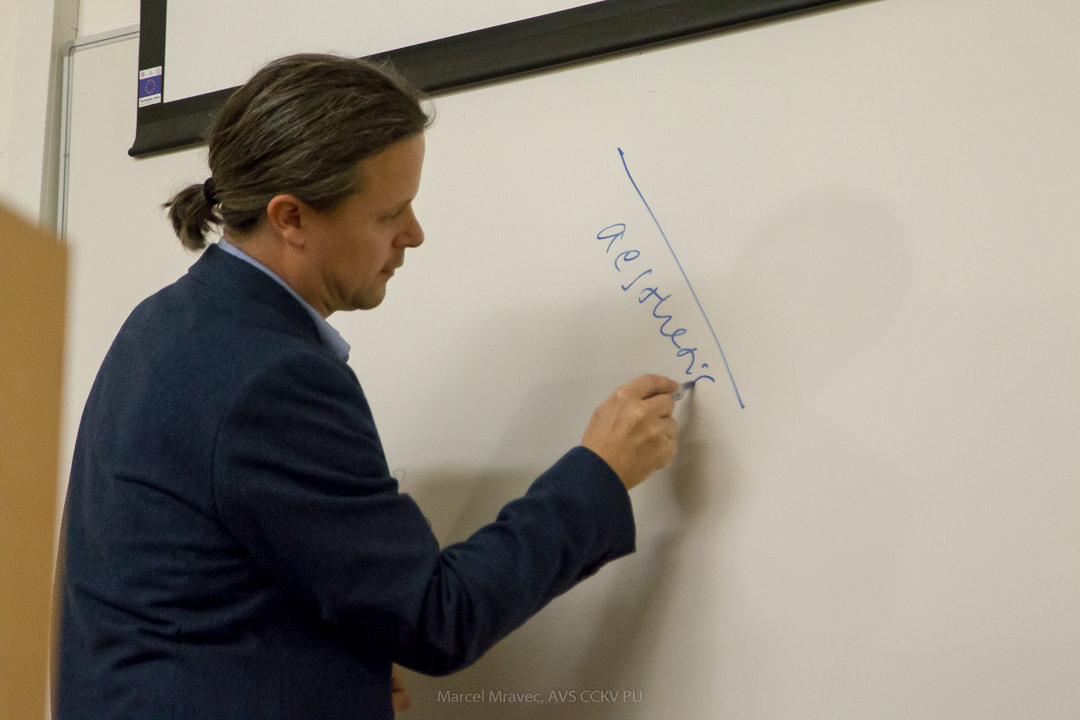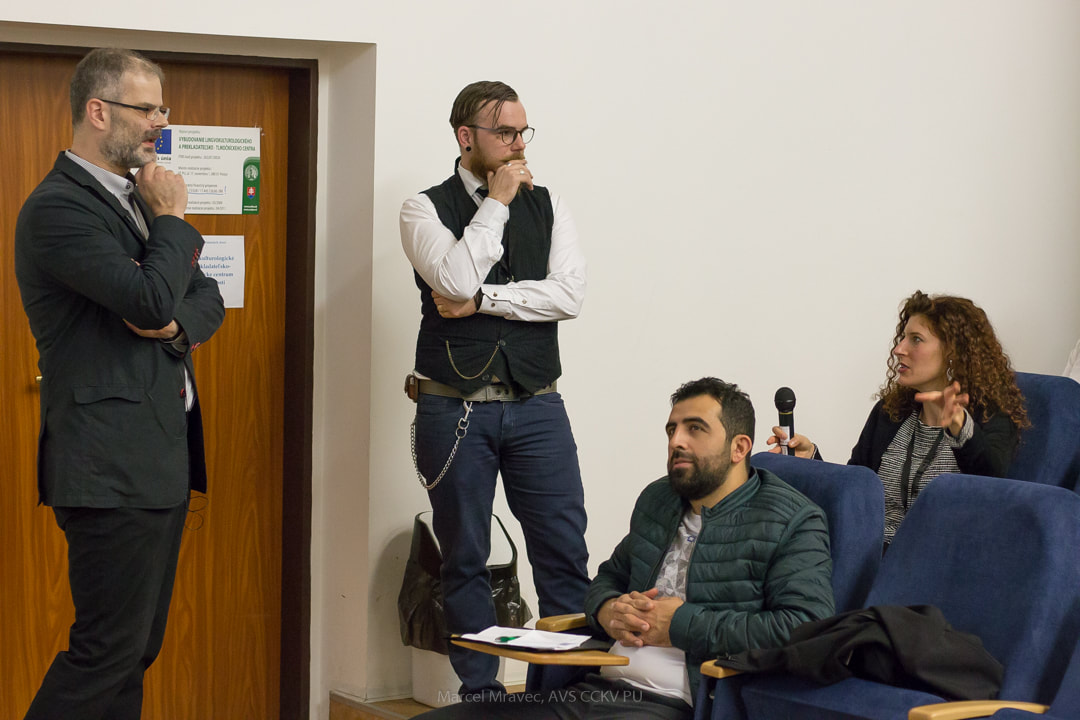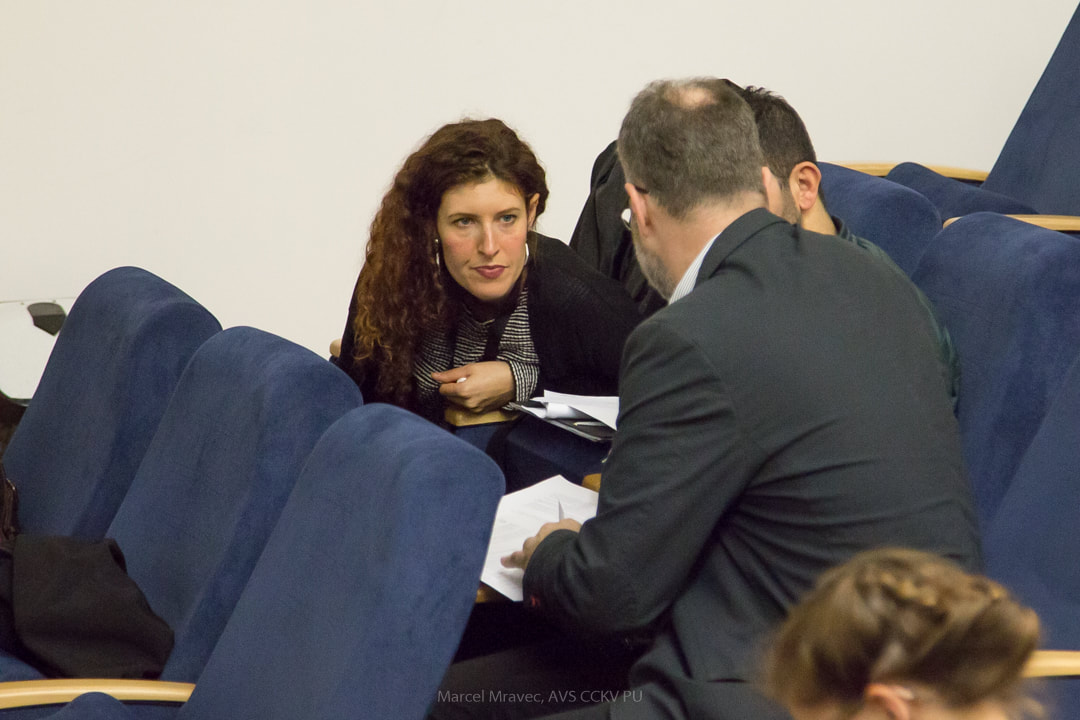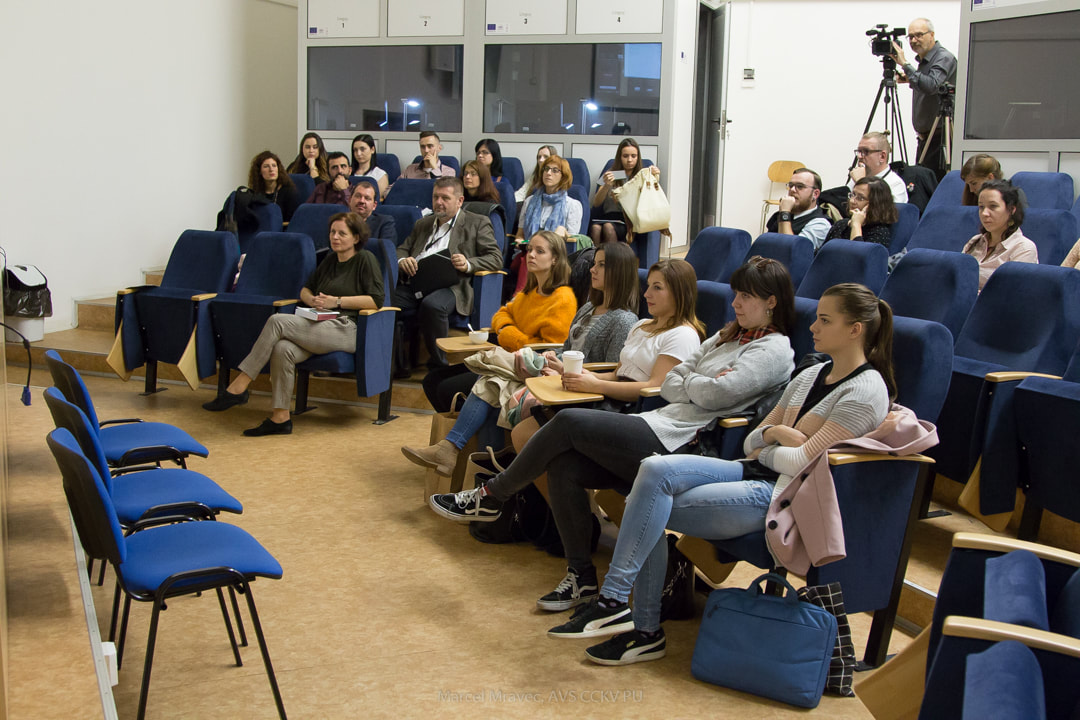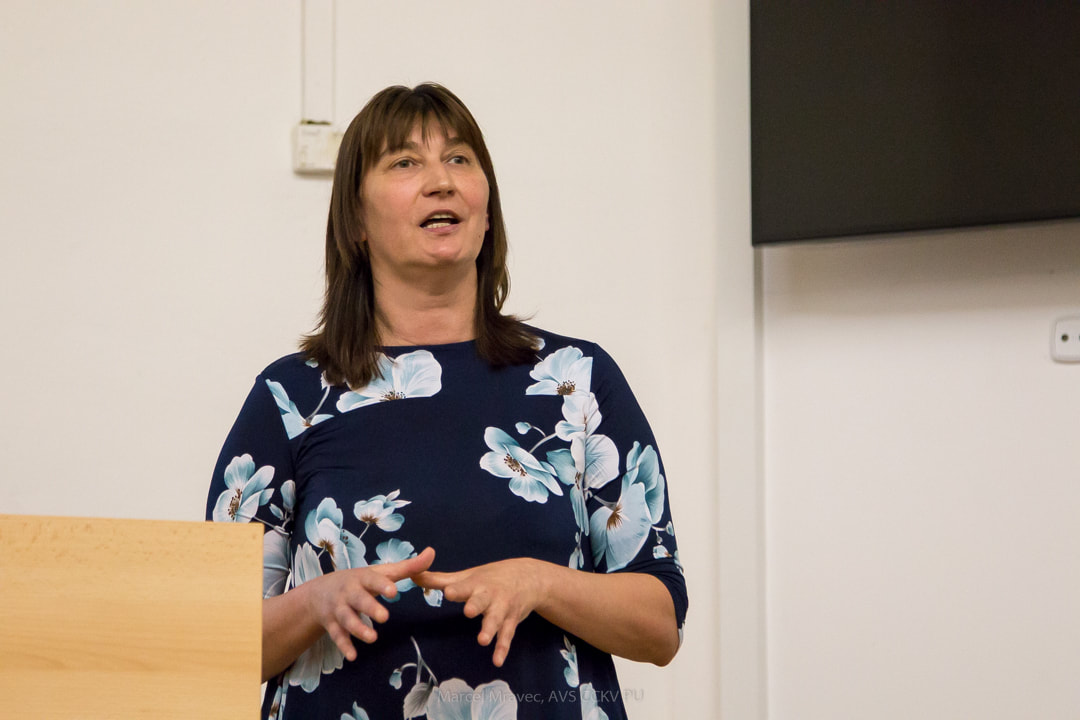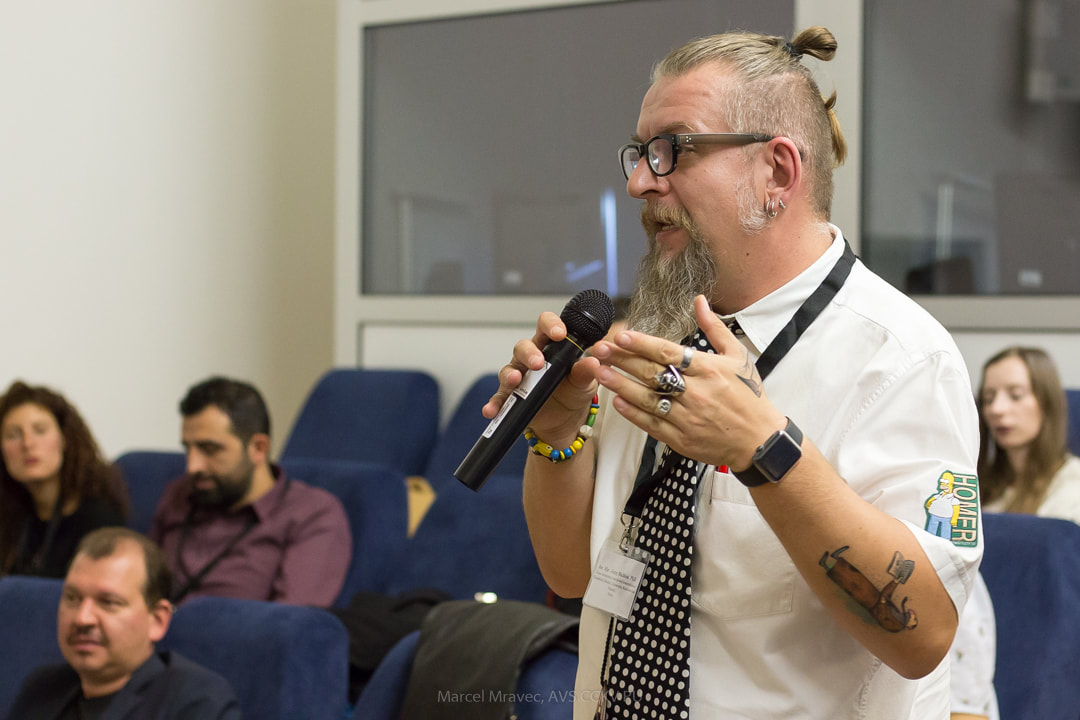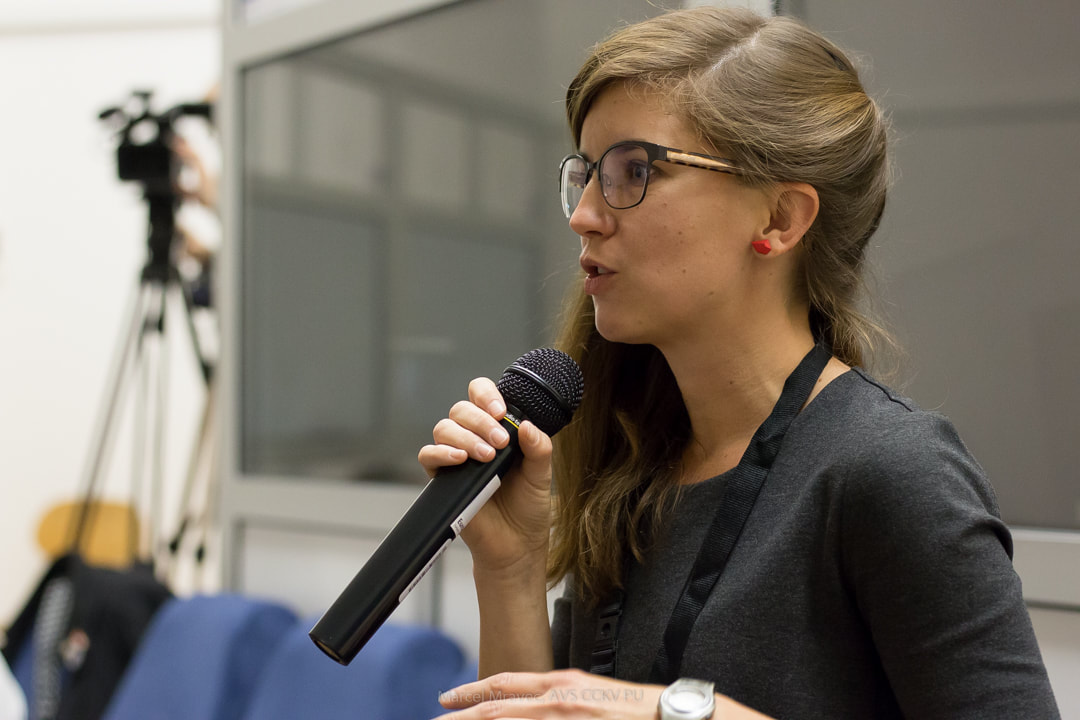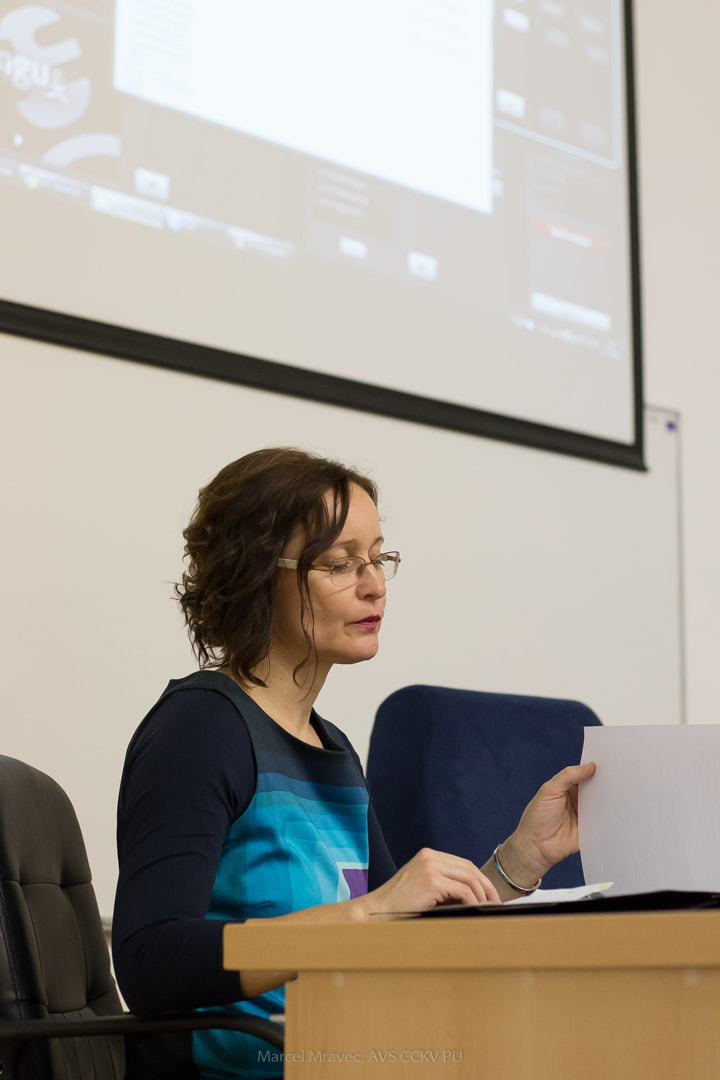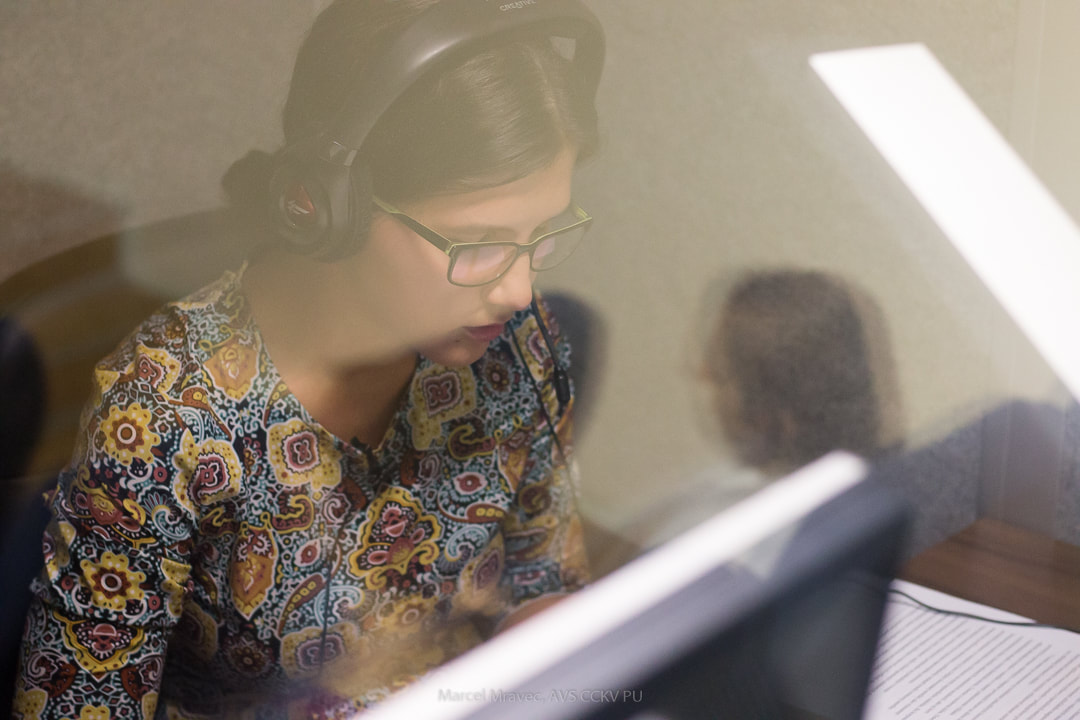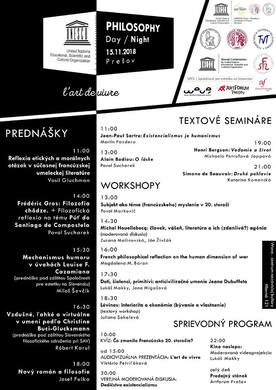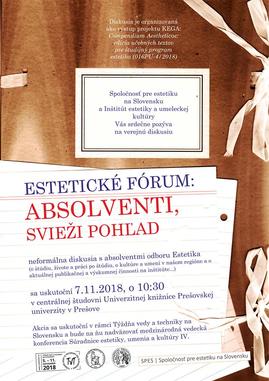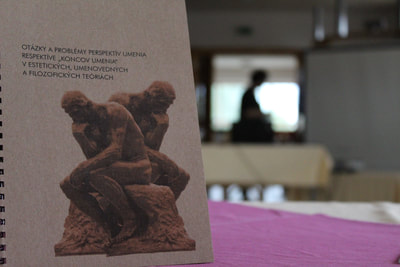Slovak Aesthetics Forum with Laia Anguix (Spain)
BUT… IS THIS ART? EXHIBITING THE CONTEMPORARY
Wednesday, 8 December · 5:00 – 6:30pm (CET)
Talk description:
Art museums are one of the main custodians, promoters and researchers of contemporary visual culture. As such, their exhibitions reflect who we currently are as a society: they display our present values, our aspirations and our limitations. This lecture aims to bring about a reflection on the challenges of dealing with this “highly flammable" material, whilst trying to engage audiences, surviving social media and navigating culture wars. Issues of political neutrality, and the potential of museum displays to encourage a reconsideration of our current aesthetic values will be central to the debate.
SHORT BIO:
Laia Anguix is a Postdoctoral Research Fellow at Trnava University (Slovakia), where she lectures on curatorial practices. Her research focuses on museum history, with particular interests in British art galleries, and gender within the curatorial profession. Some of her most recent publications feature an analysis of the impact of design exhibitions in post-war Newcastle (Journal of Design History, 2020) and a study of current gender policies at the Prado Museum in Madrid (Novecento Transnazionale, 2021). Forthcoming projects include a contribution to the exhibition catalogue of 'Uncommon Power': Lucy and Catherine Madox Brown (Watts Art Gallery, Guildford, UK) and a Paul Mellon- funded project on the revival of the Romantic British artist John Martin during the post-war years.
Estetické fórum
---
Aesthetics Forum with Alessandro Bertinetto (Italy). Photographic Improvisation
Thursday, 25 November / 6 p.m. (CET)
Talk description:
In this talk I will talk about the role of improvisation in photography.
As with reference to other visual arts, scepticism may arise about the possibility of applying the notion of improvisation to photography in a plausible way. Indeed, even if the photo is really improvised, the viewer does not directly perceive the improvisation process - as happens in the case of performing arts such as music, theatre and dance - but only its result. How is it possible to aesthetically appreciate improvisation in photography?
Based on concrete examples, I will argue that improvisation is artistically (and possibly aesthetically) relevant to photography if the photo is seen (or intended) as the result of a shot which, being both performative and creative, is the enactment of a "grammar of contingency". My account of the artistic specificity of improvisation in photography discusses the aesthetic impact of improvised photo production on the final product and addresses the question of whether it is possible for viewers to perceive (aspects of) the improvised photographic act in the photographic image.
---
American Architecture. Between Halloween and Thanksgiving
A Lecture by Prof. Emeritus Michael Lucas (California Polytechnic State University in San Luis Obispo, California, USA).
Google Meet video call link: https://meet.google.com/emt-vnxq-ngb
Abstract:
In an increasingly globalist culture, is there an “American” architecture? If so, would it be based on projects in America, or designed by American architects but built in Texas, China, Bratislava, and/or the Arctic? What would make it “American”? Is there an American way of discerning situation and possibility/opportunity that is unique?
The current season of Fall or Autumn in America is marked by two important holidays: one an official Federal [national government] Holiday of Thanksgiving, originated in American circumstance, and the other a less formally recognized but culturally important one of Halloween, that has its origins back to Celtic Europe. Thanksgiving marks the survival of Puritan colonists in the 17th century with their first harvest, shared with gifts of food by the Indigenous Peoples of the region. Halloween, or “All Hallows Eve” is a day and evening of parties, costumes and a certain fascination with the dead and even horror. Each involves different modes and places for participation, a hedonistic immediacy, and a gap of space and time for a certain pause and suspension of belief apart from the commonplace.
The evolutions of each holiday offer metaphors for reviewing contemporary architectural and urban space production. The talk will be illustrated by examples suggesting positive and negative affective influences of the sublime [Halloween]. The difficulties with production of 'official' narratives that reduce architecture to style [Thanksgiving] will be countered by the linking of aesthetics to emerging realities such as intergenerational ethics and regenerative ecological thinking.
© Image by Michael Lucas: An American Encounter with the Baroque, Karlskirche, Vienna, Austria, 2019.
Nedávne prednášky:
Aesthetics Forum with Yevheniia Butsykina (UA):
Public and Private in a Post-Soviet City: Aesthetic Aspects
Google Meet: https://meet.google.com/bmv-qyvw-onu
Abstract:
The aim of this talk is to propose an aesthetic analysis of the collision between public and private space in contemporary post-Soviet cities. By examining the case of streets, courtyards, buildings and public art in Kyiv, I suggest that Kyiv cityscape suffers from a form of fragmentation, which results exactly from this collision. This can be seen in the facades of buildings, the composition of signboards, the cluttered sidewalks, the numbers of cars, the mania of shopping malls, the visual and sound pollution of the city, and the presence of ‘private art’ in public spaces.
In the talk, different approaches to the aesthetic and interdisciplinary investigation of these phenomena will be considered, including strategies coming from environmental aesthetics (such as the cognitive approach proposed by A. Carlson, P. von Bonsdorff, et al., the so-called engagement approach advocated by A. Berleant, N. Blanc, et al., the somaesthetic approach supported by R. Shusterman, D. Macauley, et al.); the concept of heterotopia and its aesthetic interpretation within ‘post-civil societies’ (for example in Michel Foucault, Henri Lefebvre, Michel de Certeau, Lieven de Cauter, Michiel Dehaene, Clement Orillard, et al.); and the phenomenology of urban places (as one can find in M. Heidegger, E. Relph, V. Vihanninjoki, et al.).
I will focus particularly on the engagement approach by relying on the notions of urban landscape as a socio-spatial structure; the experience of the city as an aesthetic environment in its continuity, interaction and diversity; and the theme of bodily engagement as regards specifically the practice of walking in the city. Special attention will be paid to the historical and cultural references fo this discussion such as for example the concepts of public and private in political philosophy (Aristotle and H. Arendt) and the cultural and political legacy of urbanism and the ideology of the USSR.
---
Past events:
To See or Not to See, This is Not the Question:
A Speculative Realist Account of Beauty
Online lecture by dr. Swantje Martach
Google Meet link: https://meet.google.com/bgp-ipuc-yoo
ABSTRACT
The present lecture is a speculative realist approach to the question: What is beauty?, and as such consists of two parts. First I will provide a realist claim, namely that aesthetic perception only changes the reality of the perceiver (who is pleased, repelled, enjoys, feels disgust), but it does not necessarily affect the reality of the perceived. The reality of e.g. a flower is not (directly) altered by me finding it beautiful. If beauty is not constituted in perception, hence if beauty does not lie “in the eye of the beholder“, this gives rise to the thought that beauty also exists aside from perception, hence that there are unseen yet real beauties.
And this leads me to the second part of this lecture, in which I will elaborate a speculative method in order to approach meanwhile preserve these beauties in their being-unseen. I argue for speculation as the suitable method for the present undertaking, because if we would merely detect hitherto unseen beauties, they would, by this precise action, be turned into seen beauties. Instead of bluntly pointing them out, we thus need to respectfully narrate them in their fleeting, or else, to treasure them in their treacheries. Only in this manner can we not only prove the mere fact of their existence as “hidden“ beauties, but can crucially witness them in their hiding.
Join us online, at 17:00 on June 23rd.
BUT… IS THIS ART? EXHIBITING THE CONTEMPORARY
Wednesday, 8 December · 5:00 – 6:30pm (CET)
Talk description:
Art museums are one of the main custodians, promoters and researchers of contemporary visual culture. As such, their exhibitions reflect who we currently are as a society: they display our present values, our aspirations and our limitations. This lecture aims to bring about a reflection on the challenges of dealing with this “highly flammable" material, whilst trying to engage audiences, surviving social media and navigating culture wars. Issues of political neutrality, and the potential of museum displays to encourage a reconsideration of our current aesthetic values will be central to the debate.
SHORT BIO:
Laia Anguix is a Postdoctoral Research Fellow at Trnava University (Slovakia), where she lectures on curatorial practices. Her research focuses on museum history, with particular interests in British art galleries, and gender within the curatorial profession. Some of her most recent publications feature an analysis of the impact of design exhibitions in post-war Newcastle (Journal of Design History, 2020) and a study of current gender policies at the Prado Museum in Madrid (Novecento Transnazionale, 2021). Forthcoming projects include a contribution to the exhibition catalogue of 'Uncommon Power': Lucy and Catherine Madox Brown (Watts Art Gallery, Guildford, UK) and a Paul Mellon- funded project on the revival of the Romantic British artist John Martin during the post-war years.
Estetické fórum
---
Aesthetics Forum with Alessandro Bertinetto (Italy). Photographic Improvisation
Thursday, 25 November / 6 p.m. (CET)
Talk description:
In this talk I will talk about the role of improvisation in photography.
As with reference to other visual arts, scepticism may arise about the possibility of applying the notion of improvisation to photography in a plausible way. Indeed, even if the photo is really improvised, the viewer does not directly perceive the improvisation process - as happens in the case of performing arts such as music, theatre and dance - but only its result. How is it possible to aesthetically appreciate improvisation in photography?
Based on concrete examples, I will argue that improvisation is artistically (and possibly aesthetically) relevant to photography if the photo is seen (or intended) as the result of a shot which, being both performative and creative, is the enactment of a "grammar of contingency". My account of the artistic specificity of improvisation in photography discusses the aesthetic impact of improvised photo production on the final product and addresses the question of whether it is possible for viewers to perceive (aspects of) the improvised photographic act in the photographic image.
---
American Architecture. Between Halloween and Thanksgiving
A Lecture by Prof. Emeritus Michael Lucas (California Polytechnic State University in San Luis Obispo, California, USA).
Google Meet video call link: https://meet.google.com/emt-vnxq-ngb
Abstract:
In an increasingly globalist culture, is there an “American” architecture? If so, would it be based on projects in America, or designed by American architects but built in Texas, China, Bratislava, and/or the Arctic? What would make it “American”? Is there an American way of discerning situation and possibility/opportunity that is unique?
The current season of Fall or Autumn in America is marked by two important holidays: one an official Federal [national government] Holiday of Thanksgiving, originated in American circumstance, and the other a less formally recognized but culturally important one of Halloween, that has its origins back to Celtic Europe. Thanksgiving marks the survival of Puritan colonists in the 17th century with their first harvest, shared with gifts of food by the Indigenous Peoples of the region. Halloween, or “All Hallows Eve” is a day and evening of parties, costumes and a certain fascination with the dead and even horror. Each involves different modes and places for participation, a hedonistic immediacy, and a gap of space and time for a certain pause and suspension of belief apart from the commonplace.
The evolutions of each holiday offer metaphors for reviewing contemporary architectural and urban space production. The talk will be illustrated by examples suggesting positive and negative affective influences of the sublime [Halloween]. The difficulties with production of 'official' narratives that reduce architecture to style [Thanksgiving] will be countered by the linking of aesthetics to emerging realities such as intergenerational ethics and regenerative ecological thinking.
© Image by Michael Lucas: An American Encounter with the Baroque, Karlskirche, Vienna, Austria, 2019.
Nedávne prednášky:
Aesthetics Forum with Yevheniia Butsykina (UA):
Public and Private in a Post-Soviet City: Aesthetic Aspects
Google Meet: https://meet.google.com/bmv-qyvw-onu
Abstract:
The aim of this talk is to propose an aesthetic analysis of the collision between public and private space in contemporary post-Soviet cities. By examining the case of streets, courtyards, buildings and public art in Kyiv, I suggest that Kyiv cityscape suffers from a form of fragmentation, which results exactly from this collision. This can be seen in the facades of buildings, the composition of signboards, the cluttered sidewalks, the numbers of cars, the mania of shopping malls, the visual and sound pollution of the city, and the presence of ‘private art’ in public spaces.
In the talk, different approaches to the aesthetic and interdisciplinary investigation of these phenomena will be considered, including strategies coming from environmental aesthetics (such as the cognitive approach proposed by A. Carlson, P. von Bonsdorff, et al., the so-called engagement approach advocated by A. Berleant, N. Blanc, et al., the somaesthetic approach supported by R. Shusterman, D. Macauley, et al.); the concept of heterotopia and its aesthetic interpretation within ‘post-civil societies’ (for example in Michel Foucault, Henri Lefebvre, Michel de Certeau, Lieven de Cauter, Michiel Dehaene, Clement Orillard, et al.); and the phenomenology of urban places (as one can find in M. Heidegger, E. Relph, V. Vihanninjoki, et al.).
I will focus particularly on the engagement approach by relying on the notions of urban landscape as a socio-spatial structure; the experience of the city as an aesthetic environment in its continuity, interaction and diversity; and the theme of bodily engagement as regards specifically the practice of walking in the city. Special attention will be paid to the historical and cultural references fo this discussion such as for example the concepts of public and private in political philosophy (Aristotle and H. Arendt) and the cultural and political legacy of urbanism and the ideology of the USSR.
---
Past events:
To See or Not to See, This is Not the Question:
A Speculative Realist Account of Beauty
Online lecture by dr. Swantje Martach
Google Meet link: https://meet.google.com/bgp-ipuc-yoo
ABSTRACT
The present lecture is a speculative realist approach to the question: What is beauty?, and as such consists of two parts. First I will provide a realist claim, namely that aesthetic perception only changes the reality of the perceiver (who is pleased, repelled, enjoys, feels disgust), but it does not necessarily affect the reality of the perceived. The reality of e.g. a flower is not (directly) altered by me finding it beautiful. If beauty is not constituted in perception, hence if beauty does not lie “in the eye of the beholder“, this gives rise to the thought that beauty also exists aside from perception, hence that there are unseen yet real beauties.
And this leads me to the second part of this lecture, in which I will elaborate a speculative method in order to approach meanwhile preserve these beauties in their being-unseen. I argue for speculation as the suitable method for the present undertaking, because if we would merely detect hitherto unseen beauties, they would, by this precise action, be turned into seen beauties. Instead of bluntly pointing them out, we thus need to respectfully narrate them in their fleeting, or else, to treasure them in their treacheries. Only in this manner can we not only prove the mere fact of their existence as “hidden“ beauties, but can crucially witness them in their hiding.
Join us online, at 17:00 on June 23rd.
Výzva k účasti na konferencii je otvorená:
Pozývame k aktívnej účasti na konferencii Súradnice estetiky, umenia a kultúry 7:
Verejný priestor v kontextoch estetiky, umeleckej teórie a umeleckej praxe.
11. - 12. novembra 2021.
Inštitút estetiky a umeleckej kultúry Filozofickej fakulty, Prešovskej univerzity v Prešove a Spoločnosť pre estetiku na Slovensku Vás pozývajú na siedmy ročník vedeckej konferencie Súradnice estetiky, umenia a kultúry. Pozornosť bude venovaná diskusii o premenách verejného priestoru z hľadiska jeho vizuálnej statiky a dynamiky i z hľadiska udalostného rázu jeho „zapĺňa- nia“. Skúmanie verejného priestoru bolo doteraz rozpracované prevažne z urbanistického či architektonického aspektu (Worpole 2000; Gehl 2011), postupne však sledujeme jeho prenikanie do iných teoretických diskurzov či reflexií umeleckej teórie, filozofie či do umeleckej praxe.
Čítajte viac na stránkach konferencie.
Pozývame k aktívnej účasti na konferencii Súradnice estetiky, umenia a kultúry 7:
Verejný priestor v kontextoch estetiky, umeleckej teórie a umeleckej praxe.
11. - 12. novembra 2021.
Inštitút estetiky a umeleckej kultúry Filozofickej fakulty, Prešovskej univerzity v Prešove a Spoločnosť pre estetiku na Slovensku Vás pozývajú na siedmy ročník vedeckej konferencie Súradnice estetiky, umenia a kultúry. Pozornosť bude venovaná diskusii o premenách verejného priestoru z hľadiska jeho vizuálnej statiky a dynamiky i z hľadiska udalostného rázu jeho „zapĺňa- nia“. Skúmanie verejného priestoru bolo doteraz rozpracované prevažne z urbanistického či architektonického aspektu (Worpole 2000; Gehl 2011), postupne však sledujeme jeho prenikanie do iných teoretických diskurzov či reflexií umeleckej teórie, filozofie či do umeleckej praxe.
Čítajte viac na stránkach konferencie.
Vážení a milí členovia, priaznivci, sympatizanti SPES, nech sa páči, oficiálne pozvanie a program valného zhromaždenia, ktoré sa uskutoční 13. novembra 2020 (online), máte k dispozícii v položke VALNÉ ZHROMAŽDENIE, ako súbor PDF na stiahnutie, ako aj náhľad v platforme SCRIBD. Tešíme sa na Vašu účasť!
Oznámenie o najbližšom valnom zhromaždení SPES
Valné zhromaždenie SPES sa uskutoční počas konferencie Súradnice estetiky, umenia a kultúry VI., 13. novembra 2020, v piatok, o 16:00. Tešíme sa na vašu účasť. Program konferencie: https://suradniceestetiky.weebly.com
Valné zhromaždenie sa bude konať online, na platforme Google Meet. Link na podujatie: https://meet.google.com/jtk-unck-rri
The Annual Meeting of the Society for Aesthetics in Slovakia: https://meet.google.com/jtk-unck-rri
Valné zhromaždenie SPES sa uskutoční počas konferencie Súradnice estetiky, umenia a kultúry VI., 13. novembra 2020, v piatok, o 16:00. Tešíme sa na vašu účasť. Program konferencie: https://suradniceestetiky.weebly.com
Valné zhromaždenie sa bude konať online, na platforme Google Meet. Link na podujatie: https://meet.google.com/jtk-unck-rri
The Annual Meeting of the Society for Aesthetics in Slovakia: https://meet.google.com/jtk-unck-rri
Srdečne vás pozývame na výstavu archívnych a autorských fotografií z Divadla Jonáša Záborského v Prešove. Výstavu pripravili študenti a pedagógovia IEUK, je inštalovaná v priestoroch Prešovskej univerzity pred miestnosťou č. 94.
Aktuálna konferenčná výzva
(please, scroll down for and English version of the current CFP):
Súradnice estetiky, umenia a kultúry VI.:
Estetika, umenie, filozofia a každodennosť
Prešov, 12. - 13. 11. 2020
Inštitút estetiky a umeleckej kultúry Filozofickej fakulty, Prešovskej univerzity v Prešove a Spoločnosť pre estetiku na Slovensku vás pozývajú na v poradí šiesty ročník konferencie Súradnice estetiky, umenia a kultúry. Organizátori sa rozhodli preniesť pozornosť na tému estetiky a filozofie každodennosti. Napriek záujmu o danú problematiku vo svete sa Slovenska dotkol tento trend nateraz len okrajovo. Základnou ambíciou konferencie je otvoriť toto výskumné pole pre intenzívnejší výskum v slovenskom a stredoeurópskom kontexte.
V 20. storočí prebehla v estetike taká dynamická transformácia, ktorá mala za následok, parafrázujúc Mukařovského (1936), rozšírenie skúmania estetična v mimoumeleckej sfére. Oblasti, ktoré boli z pozície na umenie zacielených prístupov považované za marginálne, získavali pozornosť estetikov. Vzťahy medzi estetikou umenia a mimoumeleckou estetikou, estetikou centra a estetikou periférie či estetikami vysokého a nízkeho umenia vyústili nakoniec v plodný interdisciplinárny dialóg a produktívne teoretické uvažovanie. Skúmanie rozličných dimenzií vzťahu filozofie a života (ed. Andreánsky, 2004), viedlo k rozpracovaniu tzv. estetiky existencie (Suvák, 2007; Sisáková, 2016, 2017).
Argumentačným východiskom estetiky každodennosti sú podľa Sartwella (2005) “dva nespochybniteľné fakty: (1) umenie sa vynára z množstva mimoumeleckých aktivít a skúseností a (2) estetická sféra sa rozrastá ďaleko za hranice toho, čo vo všeobecnosti chápeme pod pojmom krásnych umení.” Estetika každodennosti sa rozvíja v nadväznosti na pragmatické myslenie Deweyho (1934), angažovanú estetiku Berleanta (1991), alebo na spochybnenie konceptu západného umenia Scharfsteinom (1988) a zažíva rozmach od 90. rokov 20. storočia (Leddy, 1995; Naukkarinen, 1999; Welsch, 1997). Po prelome milénií sa objavujú vplyvné antológie (Light - Smith, 2005; Kuisma - Lehtinen - Mäcklin, 2019) a monografie (Mandoki, 2007; Saito, 2007, 2012; Leddy, 2012; Di Stefano, 2017) a silnie záujem o nové zjednocujúce pole (estetiky environmentu, sociálnej estetiky, somaestetiky a pod.). Navzdory spochybneniam estetika každodennosti neprestáva pútať čoraz širšiu pozornosť v súčasnom vedeckom diskurze ako filozofickej tak aj aplikovanej estetiky.
Pretrváva teoretická nevyjasnenosť, v ktorej sa často zlučujú také pojmy ako mimoumelecká estetika, estetika každodennosti, estetika prírody a estetika environmentu, v širokom zmysle slova. Cieľom predloženého vedeckého podujatia je systematizácia, revízia a aktualizácia prístupov súvisiacich predovšetkým s estetikou každodennosti. Špecifickým poľom môže byť kritický pohľad na stredoeurópsky priestor ako zdroj autentických a podnetných myšlienkových konštruktov spadajúcich do predmetnej oblasti.
Inštitút estetiky a umeleckej kultúry Filozofickej fakulty Prešovskej univerzity v Prešove, ktorý je organizátorom a odborným garantom celého vedeckého podujatia, už 30 rokov mapuje transformáciu estetiky a systematicky sleduje estetické problémy vo všetkých teoretických podobách. Pri príležitosti životného jubilea jeho zakladateľky, prof. Jany Soškovej (1950), by jej organizátori radi vzdali hold a dedikovali jej túto konferenciu.
Medzi okruhy abstraktov môžu patriť (ale abstrakty nie sú nevyhnutne viazané na) tieto témy:
Teoretické problémy estetiky každodennosti
Tematizácie estetických dimenzií každodennosti v umení a mimo umenia
Filozofia (v) každodennosti
Abstrakty nepresahujúce dĺžku 350 slov budú posúdené vedeckým výborom konferencie a musia byť anonymizované. Medzi rokovacie jazyky patrí: slovenský, český a anglický jazyk. Abstrakty prosím zasielajte prostredníctvom e-mailu ako prílohu vo formáte docx alebo pdf na adresu: [email protected] s nasledujúcimi údajmi v tele správy (meno autora, afiliácia, kontaktné údaje. Uveďte prosím tiež, či by ste mali záujem viesť niektorú zo sekcií konferencie.
Základné informácie o konferencii
Konferencia sa uskutoční na pôde Filozofickej fakulty PU v Prešove v dňoch 12. - 13. novembra 2020.
Dôležité dátumy
Zasielanie abstraktov do: 30. jún 2020. Všetky zaslané abstrakty budú posúdené vedeckým výborom konferencie.
Potvrdenie o prijatí bude zaslané najneskôr do: 15. júla 2020.
Dátum pre úhradu konferenčného poplatku do: 15. septembra 2020.
Vedecký výbor
Organizačný výbor
Ďalšie praktické informácie: https://suradniceestetiky.weebly.com/domov---aktuaacutelna-vyacutezva.html
---
Call for Abstracts
Coordinates of Aesthetics, Art and Culture 6:
Art, Aesthetics, and the Philosophy of Everyday Life
12 - 13th November 2020, Prešov, Slovakia
The Society for Aesthetics in Slovakia is pleased to announce its sixth conference Coordinates of Aesthetics, Art and Culture. Submissions are invited in all areas related to the aesthetics and philosophy of everyday life. Throughout the 20th century, aesthetics underwent a series of transformations resulting in an extension of its scope far beyond the field of art (Mukařovský 1936). Phenomena that seemed marginal from an art-centered viewpoint started to draw the attention of scholars and aestheticians. The relationship between art aesthetics and aesthetics beyond art, center aesthetics and peripheral aesthetics, high-art aesthetics and low-art aesthetics gained growing relevance, arousing fruitful interdisciplinary discussion. Investigations into the different dimensions of the rapport between philosophy and everyday life (ed. Andreánsky, 2004) also led to the development of a so-called “aesthetics of existence” (Suvák, 2007; Sisáková, 2016, 2017).
Read more at our conference website: https://suradniceestetiky.weebly.com/
(please, scroll down for and English version of the current CFP):
Súradnice estetiky, umenia a kultúry VI.:
Estetika, umenie, filozofia a každodennosť
Prešov, 12. - 13. 11. 2020
Inštitút estetiky a umeleckej kultúry Filozofickej fakulty, Prešovskej univerzity v Prešove a Spoločnosť pre estetiku na Slovensku vás pozývajú na v poradí šiesty ročník konferencie Súradnice estetiky, umenia a kultúry. Organizátori sa rozhodli preniesť pozornosť na tému estetiky a filozofie každodennosti. Napriek záujmu o danú problematiku vo svete sa Slovenska dotkol tento trend nateraz len okrajovo. Základnou ambíciou konferencie je otvoriť toto výskumné pole pre intenzívnejší výskum v slovenskom a stredoeurópskom kontexte.
V 20. storočí prebehla v estetike taká dynamická transformácia, ktorá mala za následok, parafrázujúc Mukařovského (1936), rozšírenie skúmania estetična v mimoumeleckej sfére. Oblasti, ktoré boli z pozície na umenie zacielených prístupov považované za marginálne, získavali pozornosť estetikov. Vzťahy medzi estetikou umenia a mimoumeleckou estetikou, estetikou centra a estetikou periférie či estetikami vysokého a nízkeho umenia vyústili nakoniec v plodný interdisciplinárny dialóg a produktívne teoretické uvažovanie. Skúmanie rozličných dimenzií vzťahu filozofie a života (ed. Andreánsky, 2004), viedlo k rozpracovaniu tzv. estetiky existencie (Suvák, 2007; Sisáková, 2016, 2017).
Argumentačným východiskom estetiky každodennosti sú podľa Sartwella (2005) “dva nespochybniteľné fakty: (1) umenie sa vynára z množstva mimoumeleckých aktivít a skúseností a (2) estetická sféra sa rozrastá ďaleko za hranice toho, čo vo všeobecnosti chápeme pod pojmom krásnych umení.” Estetika každodennosti sa rozvíja v nadväznosti na pragmatické myslenie Deweyho (1934), angažovanú estetiku Berleanta (1991), alebo na spochybnenie konceptu západného umenia Scharfsteinom (1988) a zažíva rozmach od 90. rokov 20. storočia (Leddy, 1995; Naukkarinen, 1999; Welsch, 1997). Po prelome milénií sa objavujú vplyvné antológie (Light - Smith, 2005; Kuisma - Lehtinen - Mäcklin, 2019) a monografie (Mandoki, 2007; Saito, 2007, 2012; Leddy, 2012; Di Stefano, 2017) a silnie záujem o nové zjednocujúce pole (estetiky environmentu, sociálnej estetiky, somaestetiky a pod.). Navzdory spochybneniam estetika každodennosti neprestáva pútať čoraz širšiu pozornosť v súčasnom vedeckom diskurze ako filozofickej tak aj aplikovanej estetiky.
Pretrváva teoretická nevyjasnenosť, v ktorej sa často zlučujú také pojmy ako mimoumelecká estetika, estetika každodennosti, estetika prírody a estetika environmentu, v širokom zmysle slova. Cieľom predloženého vedeckého podujatia je systematizácia, revízia a aktualizácia prístupov súvisiacich predovšetkým s estetikou každodennosti. Špecifickým poľom môže byť kritický pohľad na stredoeurópsky priestor ako zdroj autentických a podnetných myšlienkových konštruktov spadajúcich do predmetnej oblasti.
Inštitút estetiky a umeleckej kultúry Filozofickej fakulty Prešovskej univerzity v Prešove, ktorý je organizátorom a odborným garantom celého vedeckého podujatia, už 30 rokov mapuje transformáciu estetiky a systematicky sleduje estetické problémy vo všetkých teoretických podobách. Pri príležitosti životného jubilea jeho zakladateľky, prof. Jany Soškovej (1950), by jej organizátori radi vzdali hold a dedikovali jej túto konferenciu.
Medzi okruhy abstraktov môžu patriť (ale abstrakty nie sú nevyhnutne viazané na) tieto témy:
Teoretické problémy estetiky každodennosti
- Estetika každodennosti v minulosti a súčasnosti
- Perspektívy mimoumeleckej estetiky
- Anestetika, nezainteresovanosť, angažovanosť, estetická dištancia, senzibilizácia: možné odpovede na každodenné javy
- Estetika tela a pozícia tela v somaestetike
- Estetické reflexie environmentu, prírody a mesta
- Environmentálna estetika prírody v dobe klimatickej krízy
Tematizácie estetických dimenzií každodennosti v umení a mimo umenia
- Estetika každodennosti a umenie
- Umenie verejného priestoru
- Mediálne obrazy každodennosti
- Ontológia umenia a definícia umenia v reakcii na estetiku každodennosti
Filozofia (v) každodennosti
- Filozofické problémy každodennosti
- Pragmatizmus a postpragmatizmus ako filozofické prúdy s presahom do estetiky každodennosti
- Filozofické, spoločenské a sociologické špecifiká verejného priestoru/mesta
Abstrakty nepresahujúce dĺžku 350 slov budú posúdené vedeckým výborom konferencie a musia byť anonymizované. Medzi rokovacie jazyky patrí: slovenský, český a anglický jazyk. Abstrakty prosím zasielajte prostredníctvom e-mailu ako prílohu vo formáte docx alebo pdf na adresu: [email protected] s nasledujúcimi údajmi v tele správy (meno autora, afiliácia, kontaktné údaje. Uveďte prosím tiež, či by ste mali záujem viesť niektorú zo sekcií konferencie.
Základné informácie o konferencii
Konferencia sa uskutoční na pôde Filozofickej fakulty PU v Prešove v dňoch 12. - 13. novembra 2020.
Dôležité dátumy
Zasielanie abstraktov do: 30. jún 2020. Všetky zaslané abstrakty budú posúdené vedeckým výborom konferencie.
Potvrdenie o prijatí bude zaslané najneskôr do: 15. júla 2020.
Dátum pre úhradu konferenčného poplatku do: 15. septembra 2020.
Vedecký výbor
- prof. PhDr. Jana Sošková, CSc., Filozofická fakulta PU v Prešove
- doc. PhDr. Renáta Beličová, PhD., Filozofická fakulta UKF v Nitre
- doc. PaedDr. Slávka Kopčáková, PhD., Filozofická fakulta PU v Prešove
- doc. Sandra Zákutná, PhD., Filozofická fakulta PU v Prešove
- Lisa Giombini, PhD., University of Roma Tre, Italy
- Adrián Kvokačka, PhD., Filozofická fakulta PU v Prešove
- Lukáš Makky, PhD., Filozofická fakulta PU v Prešove
Organizačný výbor
- Mgr. Lenka Bandurová, PhD., Filozofická fakulta PU v Prešov
- Mgr. Eva Kušnírová, PhD., Filozofická fakulta PU v Prešove
- Mgr. Jana Migašová, PhD., Filozofická fakulta PU v Prešove
- PhDr. Miron Pukan, PhD., Filozofická fakulta PU v Prešove
- Mgr. Tomáš Timko, Filozofická fakulta PU v Prešove
Ďalšie praktické informácie: https://suradniceestetiky.weebly.com/domov---aktuaacutelna-vyacutezva.html
---
Call for Abstracts
Coordinates of Aesthetics, Art and Culture 6:
Art, Aesthetics, and the Philosophy of Everyday Life
12 - 13th November 2020, Prešov, Slovakia
The Society for Aesthetics in Slovakia is pleased to announce its sixth conference Coordinates of Aesthetics, Art and Culture. Submissions are invited in all areas related to the aesthetics and philosophy of everyday life. Throughout the 20th century, aesthetics underwent a series of transformations resulting in an extension of its scope far beyond the field of art (Mukařovský 1936). Phenomena that seemed marginal from an art-centered viewpoint started to draw the attention of scholars and aestheticians. The relationship between art aesthetics and aesthetics beyond art, center aesthetics and peripheral aesthetics, high-art aesthetics and low-art aesthetics gained growing relevance, arousing fruitful interdisciplinary discussion. Investigations into the different dimensions of the rapport between philosophy and everyday life (ed. Andreánsky, 2004) also led to the development of a so-called “aesthetics of existence” (Suvák, 2007; Sisáková, 2016, 2017).
Read more at our conference website: https://suradniceestetiky.weebly.com/
|
Too Good to be True.
Plagiarism, Authenticity and the Arts Filozofka umenia a estetička z Universita Roma Tre (Taliansko) - dr. Lisa Giombini, ktorá je momentálne na svojom výskumnom pobyte v Prešove (Inštitút estetiky a umeleckej kultúry, FF PU v Prešove) prednesie výsledky svojich výskumov populárnou formou (v anglickom jazyku) v stredu, 11. 12. 2019 o 11:00, v Galérii Caraffova väznica v Prešove. Dr. Giombini je významnou výskumníčkou v oblasti hudobnej ontológie, no v ostatnom období sa venuje najmä problematike filozofických aspektov reštaurovania a autenticity pamiatok po ničivých zásahoch prírodných katastrof. Je autorkou knihy Musical Ontology: a Guide for the Perplexed (Mimesis, 2017) a členkou niekoľkých európskych a svetových filozofických organizácií. V prešovskej Galérii v Caraffovej väznici sa predstaví prednáškou Too Good to be True. Plagiarism, Authenticity and the Arts (Príliš dobré na to, aby to bola pravda. Plagiátorstvo, autenticita a umenie). V odhaľovaní tejto fascinujúcej témy sa bude zaoberať otázkami nevyhnutnosti autenticity a originality vo svete estetiky umenia a spochybní negatívne vnímanie plagiátorstva. Naopak, poskytne pohľad, ktorým by sme mohli vnímať plagiátorstvo ako bežnú, normálnu umeleckú prax. |
|
Workshop for students and teachers at University of Presov. Everybody who is interested in aesthetics, ethics, philosophy, everyday life, art (and of course in speaking in English with us) is more than welcome! The topic is universal: we will deal with urban modern life, banality, mechanization, allienation, human sensitivity, etc. Workshop will be leaded by: Lisa GIOMBINI (University of Roma Tre), Lukas MAKKY (FF PU) and Jana MIGASOVA (FF PU).
|
Valné zhromaždenie sa uskutočnilo 8. novembra na pôde FF PU v Prešove, v miestnosti č. 94, ako súčasť medzinárodnej konferencie Súradnice estetiky, umenia a kultúry V, jeho program si môžte stiahnuť v položke Valné zhromaždenie.
Ďakujeme za vašu účasť na konferencii, fotografie z podujatia si môžte prezrieť TU (Conference photos).
|
Program vedeckej konferencie s medzinárodnou účasťou Súradnice estetiky, umenia a kultúry V (7. - 8. november 2019) si môžte stiahnuť tu / Programme for download:
|
| ||||||
POZVÁNKA NA KONFERENCIU
INŠTITÚT ESTETIKY A UMELECKEJ KULTÚRY FILOZOFICKEJ FAKULTY PREŠOVSKEJ UNIVERZITY V PREŠOVE
A SPOLOČNOSŤ PRE ESTETIKU NA SLOVENSKU
vás pozývajú na vedeckú konferenciu s medzinárodnou účasťou
SÚRADNICE ESTETIKY, UMENIA A KULTÚRY V
Prešov, 7. - 8. 11. 2019
Estetická výchova a prax vyučovania estetiky v kontextoch európskeho
estetického myslenia 19. a 20. storočia – dialóg s tradíciou a súčasné koncepcie
* Pozvánka a prihláška je nižšie na stiahnutie.
CALL FOR PARTICIPATION
Faculty of Arts of University of Presov, Institute of Aesthetics and Art Culture
& Society for Aesthetics in Slovakia
INVITES YOU TO THE SCIENTIFIC CONFERENCE:
COORDINATES OF AESTHETICS, ART, AND CULTURE V
Presov, November 7th – 8th, 2019
Aesthetics Education and the practice of Aesthetics teaching in the frame of 19th -20th century European aesthetics thinking –
a dialogue between traditional and current concepts
* Call for participation and application form is below.
|
| ||||||||||||
|
| ||||||||||||
|
IEUK a SPES pripravili workshop s názvom New Media Arts, ktorý vedie dr. Tufan Acil z Freien Universitat v Berlíne. Workshop sa týka transformácie súčasného umenia pod vplyvom nových technológií a médií. Prebiehať bude v dvoch blokoch - textová časť a interpretačná časť. Zúčastnia sa študenti, vyučujúci aj kolegovia z príbuzných inštitúcií. Dátum a čas: 7. máj 2019, 10:30-12:30, 13:30-15:30. Miestnosť číslo 475 na pôde Filozofickej fakulty PU v Prešove.
|
TRETIE VALNÉ ZHROMAŽDENIE
sa uskutočnilo v rámci 5. ročníka konferencie Súradnice estetiky, umenia a kultúry, dňa 8.11.2019, v priestoroch FF PU v Prešove, jeho program si môžte stiahnuť v položke Valné zhromaždenie.
sa uskutočnilo v rámci 5. ročníka konferencie Súradnice estetiky, umenia a kultúry, dňa 8.11.2019, v priestoroch FF PU v Prešove, jeho program si môžte stiahnuť v položke Valné zhromaždenie.
|
Estetické fórum 2019: pozvánka na domácu verejnú prednášku.
|
Prednášajúcou je prof. PhDr. Jana SOŠKOVÁ, Csc.
Názov prednášky: Estetické názory a filozofia umenia významného slovenského filozofa Svätopluka Štúra (1901-1981) Anotácia: Autorka v prednáške predstaví estetické a filozofické názory a názory na povahu umenia a jeho zmysel jedného z významných slovenských filozofov – Svätopluka Štúra (1901-1981), ktoré autor publikoval v sérii článkov v rokoch 1927-1936 v časopise Prúdy. V nich autor komentuje, analyzuje, kritizuje predvádzanú umeleckú tvorbu či už v galériách, koncertných sieňach, divadelných a operných predstaveniach v centrách kultúry vtedajšieho Československa (Bratislava a Praha) a porovnáva zverejnené diela a kvalitu ich reprezentácie s dianím v ostatných častiach Európy, najmä Viedne a radom nemeckých miest, ale aj Paríža. Jeho názory ukazujú dôslednosť aplikácie zvolenej metódy (intuitivistická estetika), rešpektovanie práv autora umeleckého diela predviesť v diele „umenie ako tvorenie“, a rešpektovanie práv vnímateľa umenia viesť dialóg s dielom a jeho predvedením. Tieto články formovali vtedajšiu odbornú aj laickú mienku o predvádzaných umeleckých dielach a boli zakotvené v produktívnej vedome zvolenej metodológii. |
Estetické fórum 2019: pozvánka na hosťovskú prednášku (invitation for a guest lecture):
KONFERENČNÁ VÝZVA | CALL FOR PAPERS
OTÁZKY A PROBLÉMY PERSPEKTÍV UMENIA, RESPEKTÍVE „KONCOV UMENIA“ V ESTETICKÝCH, UMENOVEDNÝCH A FILOZOFICKÝCH TEÓRIÁCH
Číslo II.
[17. – 19. máj 2019] Vysoké Tatry;
Deadline pre podávanie prihlášok: 10. apríl 2019.
Pre viac informácií v slovenskom a anglickom jazyku kliknite na pdf.
OTÁZKY A PROBLÉMY PERSPEKTÍV UMENIA, RESPEKTÍVE „KONCOV UMENIA“ V ESTETICKÝCH, UMENOVEDNÝCH A FILOZOFICKÝCH TEÓRIÁCH
Číslo II.
[17. – 19. máj 2019] Vysoké Tatry;
Deadline pre podávanie prihlášok: 10. apríl 2019.
Pre viac informácií v slovenskom a anglickom jazyku kliknite na pdf.
| konferenčná_výzva_2019_ieuk_koniec_umenia.pdf | |
| File Size: | 523 kb |
| File Type: | |
| call_for_papers_2019_end_of_art.pdf | |
| File Size: | 493 kb |
| File Type: | |
Pozrite si fotografie z konferencie Súradnice estetiky, umenia a kultúry IV.
Milí členovia, srdečne vás pozývame na každoročnú konferenciu série Súradnice estetiky, umenia a kultúry, tentokrát už vo svojom štvrtom pokračovaní s tematickým vymedzením: ŠTUDOVAŤ ESTETIKU: KONCEPCIE, STRATÉGIE A SÚVISLOSTI ŠTÚDIA ESTETIKY NA SLOVENSKU A V ZAHRANIČÍ. Vrámci programu konferencie je naplánované Valné zhromaždenie SPES - v piatok, 9. 11. 2018, o 9:30, v miestnosti 91 (FF PU v Prešove). Tešíme sa na Vašu účasť. Program konferencie k stiahnutiu nižšie:
| program_suradnice_coordinates_2018_svk_eng.pdf | |
| File Size: | 547 kb |
| File Type: | |
Druhé valné zhromaždenie SPES
sa uskutočnilo počas trvania konferencie Súradnice estetiky, umenia a kultúry IV., teda 8. a 9. novembra 2018, jeho program si môžte stiahnuť v položke Valné zhromaždenie.
sa uskutočnilo počas trvania konferencie Súradnice estetiky, umenia a kultúry IV., teda 8. a 9. novembra 2018, jeho program si môžte stiahnuť v položke Valné zhromaždenie.
Výzva k účasti na konferencii
SPES a Inštitút estetiky a umeleckej kultúry vyzýva k účasti na každoročnej konferencii Súradnice estetiky, umenia a kultúry IV., ktorá sa uksutoční 8. a 9. novembra 2018 v priestoroch FF PU v Prešove a má tematické vymedzenie: ŠTUDOVAŤ ESTETIKU: KONCEPCIE, STRATÉGIE A SÚVISLOSTI ŠTÚDIA ESTETIKY NA SLOVENSKU A V ZAHRANIČÍ .
Stiahnite si oficiálny pozývací dokument vo formáte PDF:
SPES a Inštitút estetiky a umeleckej kultúry vyzýva k účasti na každoročnej konferencii Súradnice estetiky, umenia a kultúry IV., ktorá sa uksutoční 8. a 9. novembra 2018 v priestoroch FF PU v Prešove a má tematické vymedzenie: ŠTUDOVAŤ ESTETIKU: KONCEPCIE, STRATÉGIE A SÚVISLOSTI ŠTÚDIA ESTETIKY NA SLOVENSKU A V ZAHRANIČÍ .
Stiahnite si oficiálny pozývací dokument vo formáte PDF:
| cfp_suradnice_iv_presov_preview_1_.pdf | |
| File Size: | 357 kb |
| File Type: | |
Vedecká konferencia OTÁZKY A PROBLÉMY PERSPEKTÍV UMENIA RESPEKTÍVE „KONCOV UMENIA“... vo Vysokých Tatrách prebehla zaujímavo a podnetne. Ďakujeme všetkým prítomným. Konala sa v piatok a sobotu, 17. a 18. mája, súčasťou programu bolo Valné zhromaždenie SPES, po ktorom máme nových členov, došlo k úprave stanov a k predstaveniu programu na rok 2018. Viac sa dozviete zo zápisnice. Tu je niekoľko momentov a súbor abstraktov na stiahnutie:
| zbornik_abstraktov_tatry_ii.pdf | |
| File Size: | 4946 kb |
| File Type: | |
Fotografie z podujatia sme dočasne z webu stiahli, z dôvodu rešpektovania aktuálnych nariadení GDPR.
SOBOTA, 19. 5. 2018 sa v Novom Smokovci uskutoční Valné zhromaždenie SPES.
Stiahnite si pozvánku a program valného zhromaždenia.
Stiahnite si pozvánku a program valného zhromaždenia.
| valne_zhromazdenie_spes_vysoketatry.pdf | |
| File Size: | 88 kb |
| File Type: | |
PIATOK A SOBOTA, 18. a 19. 5. 2018 sa v Novom Smokovci uskutoční vedecká konferencia OTÁZKY A PROBLÉMY PERSPEKTÍV UMENIA RESPEKTÍVE „KONCOV UMENIA“ V ESTETICKÝCH, UMENOVEDNÝCH A FILOZOFICKÝCH TEÓRIÁCH. Miesto konania: hotel Villa Siesta, Nový Smokovec, Vysoké Tatry. Stiahnite si program konferencie.
| program_konferencie__final_aktual.pdf | |
| File Size: | 536 kb |
| File Type: | |
PIATOK, 27. 4. 2018 sa v Centrálnej študovni univerzitnej knižnice Filozofickej fakulty PU v Prešove
konala neformálna diskusia so Zuzanou Štelbaskou - redaktorkou, spisovateľkou, dramaturgičkou, absolventkou Inštitútu estetiky a umeleckej kultúry. Udalosť bola súčasťou cyklu prednášok a diskusií "Estetické fórum".
konala neformálna diskusia so Zuzanou Štelbaskou - redaktorkou, spisovateľkou, dramaturgičkou, absolventkou Inštitútu estetiky a umeleckej kultúry. Udalosť bola súčasťou cyklu prednášok a diskusií "Estetické fórum".
Úspešná osobnosť slovenských médií a autorka - spisovateľka Zuzana Štelbaská predstavila svoju profesnú cestu, postoje a idey nie len v oblasti slovenskej mediálnej scény a novinárskej obce, ale pripomenula jej skúsenosti so štúdiom estetiky na FF PU a mimoriadne zaujímavo zhodnotila výhody štúdia tohto odboru. V niektorých momentoch sa diskusia nevyhla takým témam ako súčasná vyhrotená situácia v slovenskej novinárskej obci, stav súkromných televíznych médií na Slovensku, či gýčová produkcia niektorých televíznych programov. Diskusia bola plodná a podnetná pre množstvo odborných, interdisciplinárnych, ale aj životných úvah. Zuzane Štelbaskej a prítomným kolegom ďakujeme za pozornosť a diskusné príspevky.

